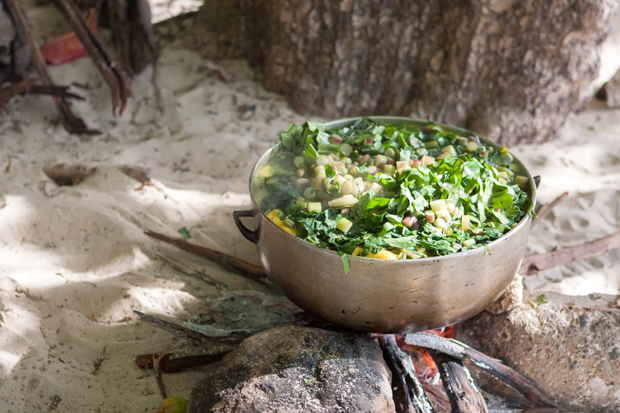
There’s nothing glamorous or refined about oil down; it’s a humble dish from a humble country. On this small Caribbean island, where hard-working locals have to deal with limited freshwater, seasonal rainfall, and natural disasters, and where the majority of its food is imported from the US and neighboring islands, Grenadians are proud to claim oil down as their own.
The majority of the locals here are of African origin, the descendants of slaves brought over to work on European-owned plantations. Although Grenada became an independent country in 1974, it has retained an identity deeply rooted in European culture. Many street names, neighborhoods, and bays (Mont Tout, Carenage, Morne Rouge) have French influence, while the currency (Eastern Caribbean dollar) pays tribute to the queen of England, and British English is taught in schools. As a result, the local customs, language, food, religion, and architecture are a rich blend of each of these different influences, each lending a unique flavor to the culture of Grenada.

Although many things in Grenada have been influenced by the Europeans over the years, oil down remains something purely Grenadian. No imported spices or seasonings, no choice cuts of meat here. This one-pot meal is made up of local veggies, “provisions” (the local term for starchy roots, tubers, and bananas that fill you up), salted meat, and aromatic seasoning —  all easily accessible, affordable ingredients in Grenada. All these components are combined in a large pot and cooked down in coconut milk over an open fire. In fact, the name of the dish comes from the coconut oils released from the coconut milk as it simmers and is absorbed by the other ingredients.
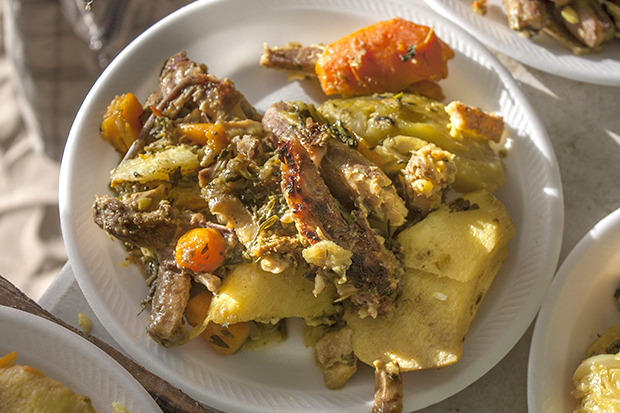
Oil down is comfort food at its Caribbean best. And of course, like any comfort food, mom or grandma always makes the best version! I was fortunate to have gotten to know someone local to the island whom I could ask to teach me how to make this dish. During my time in Grenada, I frequented the public market in St. George’s often enough that I became friends with a lot of my favorite vendors there. In particular, I ordered so much handmade jewelry from Billy that we were soon on a first-name basis. I’d stand there and watch him make jewelry some days, we’d haggle good-naturedly over different pieces, and when my friends and I had heavy bags filled with mangoes and bananas from the market, we’d leave them with Billy as we finished our shopping in town. We even spent an afternoon with Billy and his friends trekking through the rainforest, as he showed us where he collects his seeds for jewelry-making. So, it didn’t take too much convincing when I asked Billy to show me how to make oil down.
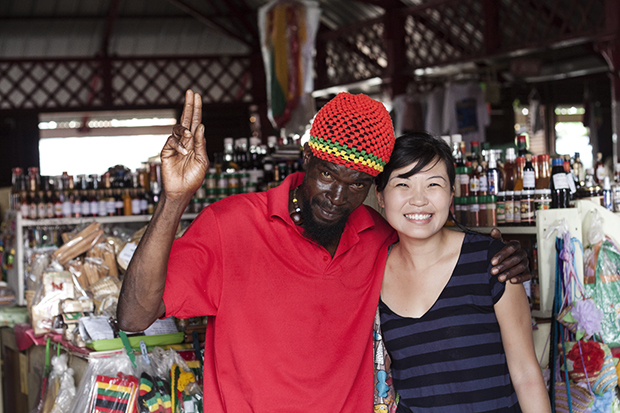
Our day began at the market where Billy and his friends showed us the ingredients we’d need for making this dish. After picking up all these items, we lugged everything (including a huge pot) to the beach to begin our cookout. When your meal needs time to simmer, the beach is the best place to wait!
While this dish is relatively easy to make (throw everything in a pot and let it simmer!), it usually turns into an all-day event. Because it tastes best cooked over an open flame, families will often make oil down at the beach, at sporting events, at hashes (organized, weekly hikes around the island), or any place where you need to feed a large group of people. And if you know Grenadians, they love to lime (a Grenadian term for something like “chilling”). In fact, “oil down” actually refers to both the dish as well as the act or event of making it. An oil down typically involves families spending the whole day at the beach. Everybody pitches in to help, and as the food cooks, children will jump in the water, young boys will play soccer, moms will watch the babies, and the men will lounge around, liming. You can’t truly experience this dish without taking part in the making and sharing of it!
I hope that by recording this recipe, I can pay tribute in some small way to Billy, to the friends I met on the island, and to the two years that my husband and I shared together so far away from home. Yes, Grenada is not in the media much (aside from the invasion by the US in the 80s), nor is it at the top of anybody’s must-see travel destinations (heck, I couldn’t even convince my sister to visit me while I was there!), but it has a simplicity and sincerity that I’ve grown to love and miss after I left just two months ago. The island’s only recently become more tourist-friendly, but many locals still don’t really know how to interact or deal with foreigners (they’ll often resort to either catcalling or brusqueness). But if you have a thick skin, an open mind, and are sure to mind your “morning,” “afternoon,” or “good nights,” you’ll find some of the friendliest, kindest people you’ll ever meet.
Oil down, in all its simple and unassuming nature, has really come to represent Grenada for me — something I can bring back home and remember the island by. At first glance, the dish doesn’t look like it has much to offer, and you may not quite know what to make of it. It’s not exactly a stew, nor a curry. And it’s lost a lot of its vibrant colors after simmering for so many hours. But if you’ll take the time to dig a little deeper, open up yourself, and give it a chance, you’ll find hidden beneath modest ingredients, the very heart and soul of a country and its people.
Oil Down
serves 4-6 as a meal
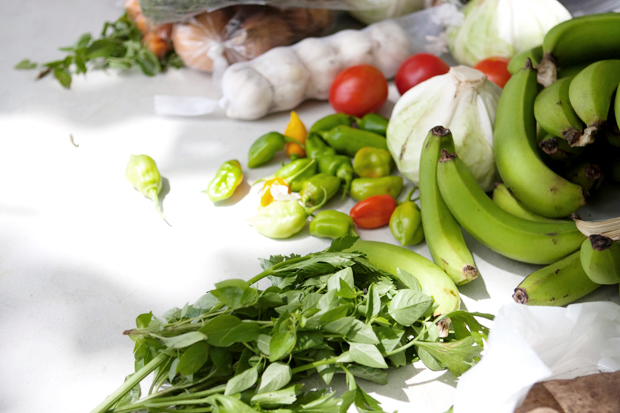
Many of the ingredients found in oil down are native to Grenada and other Caribbean countries, so I’ve done my best to suggest alternatives for my readers who may not live on a tropical island. :) Also, please use the quantities as a guideline for creating your own version of oil down. One of the best parts about this dish is the flexibility of it: use pork, chicken, or fish as your main meat; take out some starches and throw in extra callaloo, spinach, or cabbage for more greens; throw in extra spices and seasonings to suit your taste! The photos show a double batch of the recipe listed below, so the ingredients listed are smaller quantities than shown in the photos.Â
Ingredients:
2 lbs chicken
1 sprig basil
1 sprig fresh thyme
2 sprigs of celery leaves
5 Caribbean seasoning peppers (or sweet peppers)
1/2 onion
6-7 cloves garlic
2 carrots
½ bunch of callaloo leaves (taro leaves) (or 1 bunch of spinach)
2 yams (this kind, not sweet potatoes)
8 green bananas (or 4 potatoes)
1 breadfruit (or canned breadfruit or 1 large taro root)
1/2 lb. salted fish or pork
4 fresh turmeric (or 1 Tbsp. turmeric powder)
1 brown, mature coconut  + 6 cups water (or 3 cups canned coconut milk +  3 cups water)
1 cabbage
2 cups flour
1. Rinse and chop up your chicken. Toss it into the bottom of the largest pot you own (a stock pot or a dutch oven works well).
2. Soak your salted fish or pork in water to get rid of the extra salt and preservatives. Set aside for later use. If you don’t have access to salted fish or pork or simply prefer making your own, liberally salt a piece of pork overnight and then rinse off when ready to use.
3. Prepare your seasonings and herbs. Peel the garlic, slice the onions, seed and chop peppers. Chop up celery sprigs, thyme, and basil. Throw everything into the pot, on top of the chicken.
4. Chop the breadfruit in half and let it rest for 15 minutes. They will dispel some sticky liquid that you can then rinse off. Quarter the breadfruit, slice off the core and peel. Layer over the spices. As a substitute, you can use canned breadfruit or taro root. Breadfruit has a very unique, spongey texture, so taro doesn’t really do it justice, but it will soak up the coconut milk all the same.
5. Peel the green bananas and rinse them off. Peeling these guys can be really tricky! It took me and my friends a good five minutes to peel each banana, but our Grenadian friends could do them in about a minute. Substitute potatoes or another starch if you’re unable to find green bananas. Plantains don’t really work very well as a substitute because they are still quite sweet. These green bananas are not sweet at all and taste very similar to potatoes or taro when cooked. You can omit them altogether as well.
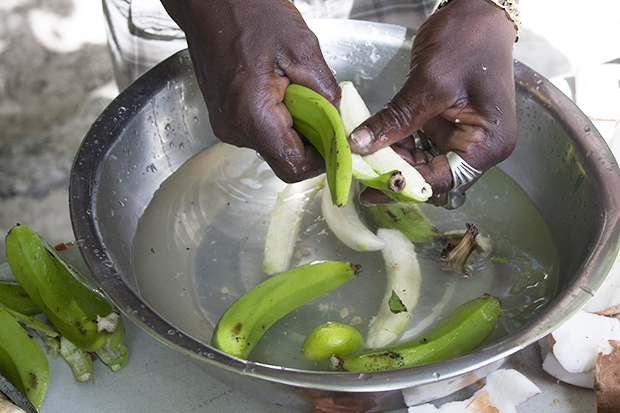
6. Peel and chop up the carrots and yams. Place them on top of the green bananas.

7. Remove your fish or pork from the water and rinse well. Scrape off any skin, fins, or otherwise undesirable parts. ;) Layer on top of the carrots and bananas.
8. Now it’s time to add in the coconut milk! We have the luxury of having access to fresh coconuts and coconut milk in Grenada. Even if you don’t feel like cracking your own coconuts, you can buy frozen, local coconut milk and shredded coconut at the store there. Here, our friend Billy cracks open two coconuts.
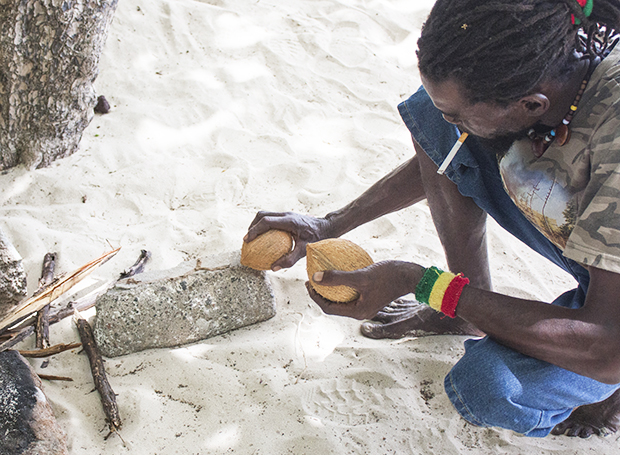
Next, you’ll peel off the hard shell. It’s not necessary to peel off all the dark skin inside the shell since we’ll be grating the coconut anyway. Grate the coconut chunks and the fresh turmeric into a large bowl. Fill the bowl with six cups of water. Gently massage the coconut and turmeric mixture until the water looks milky orange.
Squeeze out the liquid from the pulp with your hands. Discard the pulp (or save for another recipe). Strain the remaining pulpy liquid through a fine-mesh strainer.
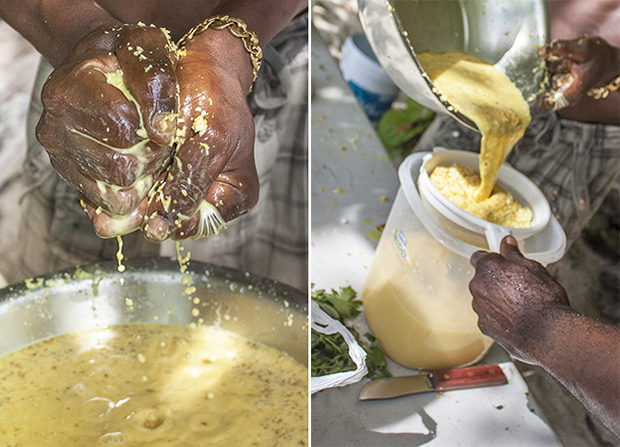
Pour the liquid into the pot, reserving 3/4 cup of it to make dumplings . There should be enough liquid to cover the ingredients.
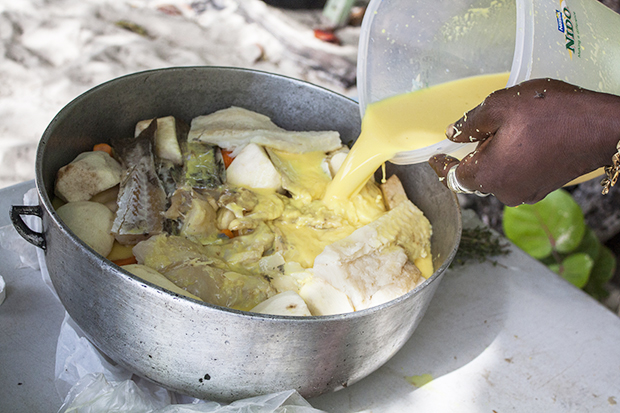
9. Place the pot on the fire (stove) and let it start simmering.
10. Meanwhile, add in the cabbage. Quarter them, leaving the core in place so the quarters stay intact.
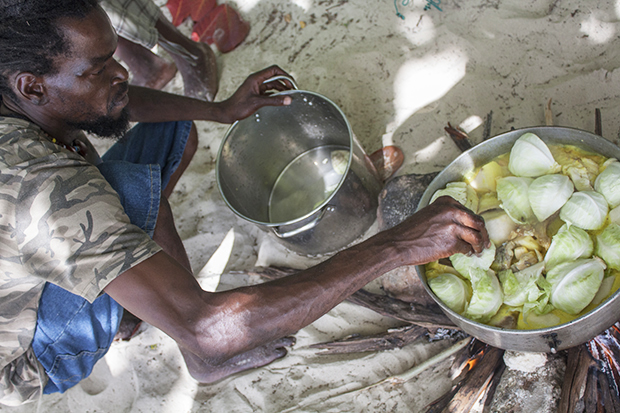
11. As the pot is simmering away, make your flour dumplings by mixing the coconut-turmeric liquid with 2 cups of plain flour. Roll the dumplings into long logs and place over the cabbage to cook.
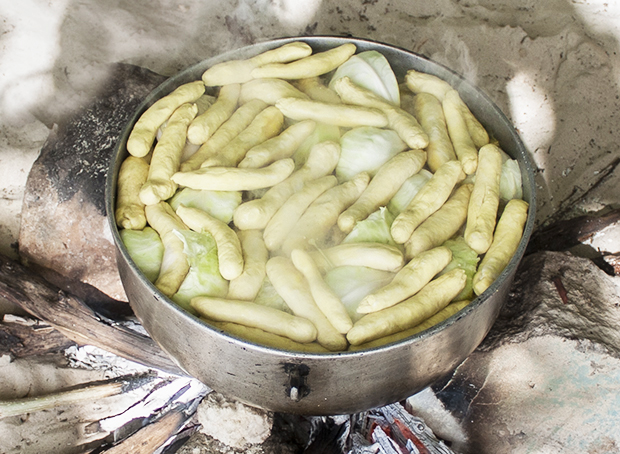
12. Lastly, rinse and chop up the callaloo into small pieces. Place on the very top of all your ingredients to seal everything in and cover firmly with a lid.
13. In about 20-30 minutes, you should start smelling the aroma of all the spices, meat, and coconut milk mixing together. Traditionally, the dish is finished when all the liquid has been absorbed, which usually takes at least an hour, depending on the size of your pot. However, when I make this at home, I like to have some of the liquid remaining so that the dish is more like a stew. I find the “coconut broth” to be the most fragrant part of the dish, and I find it such a waste when it is diluted/soaked up by all the starches. Still, the true, Grenadian way to eat this dish is to wait until the liquid is absorbed.
14. After the liquid is absorbed, gently remove each layer and separate it onto different platters.
Here is the very top layer of callaloo, cabbage, and dumplings removed.
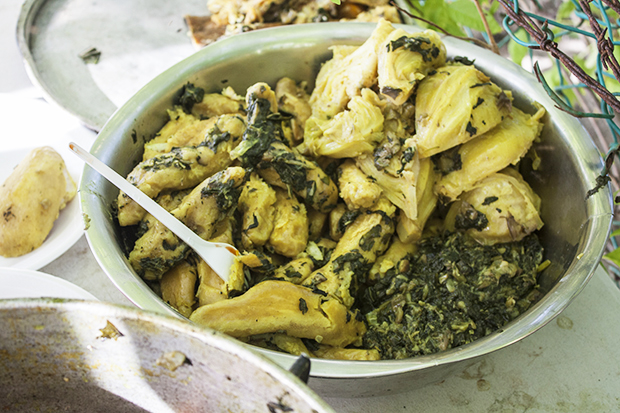
Underneath that, you can see all the other starches and finally, the meat.
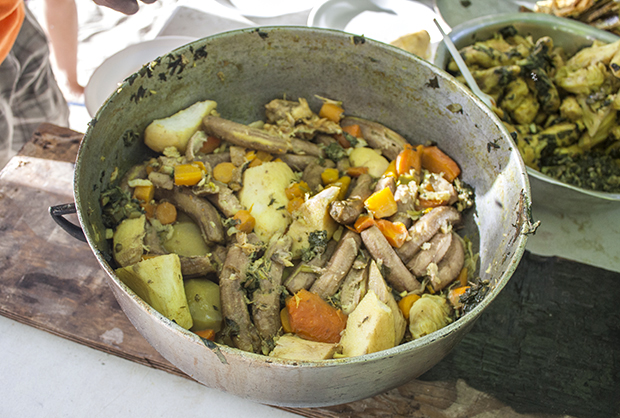
15. When you plate the dish, add a little bit of each layer onto the plate: some meat, fish (tail!), breadfruit, banana, yam, carrots, callaloo, cabbage, and dumpling. Dig in!
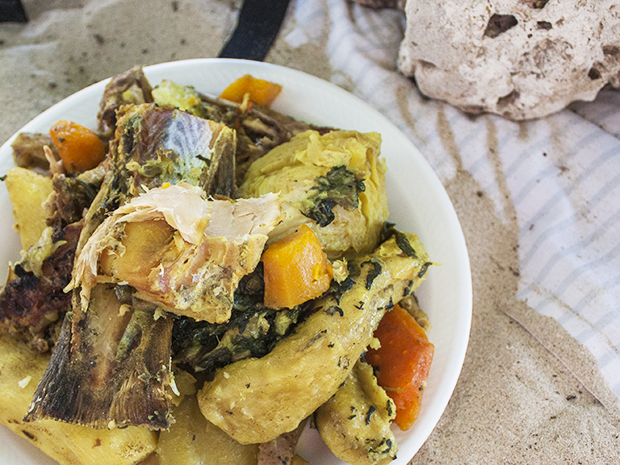
Photos  1-3, 5, 10-11, 39-41, 46-48 by Katherine Fung



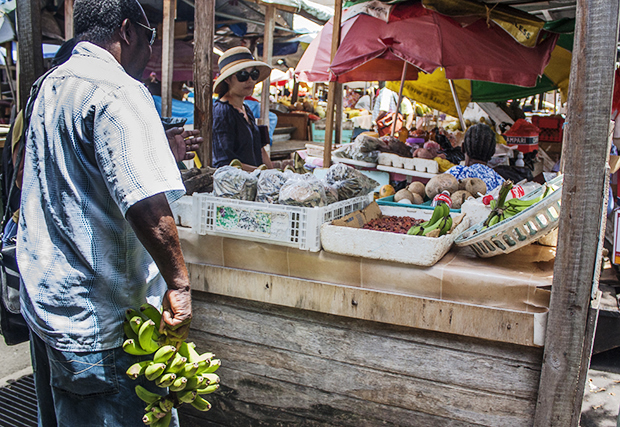


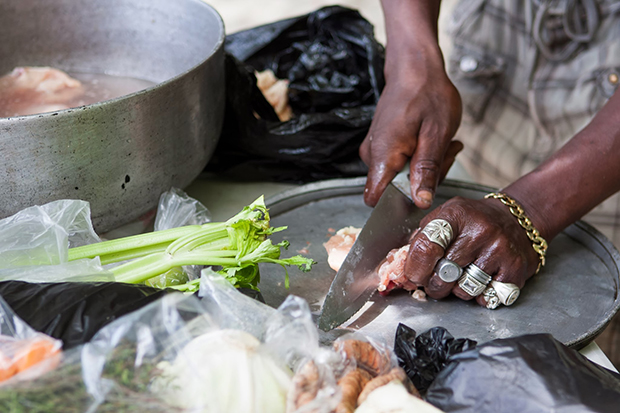

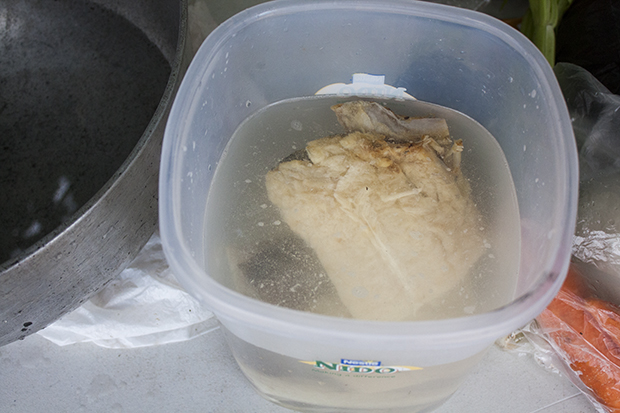
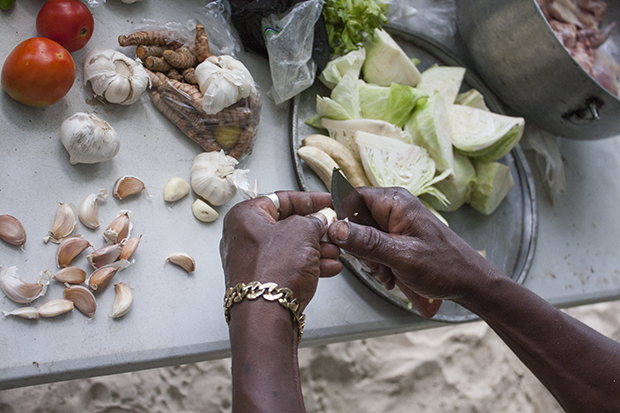
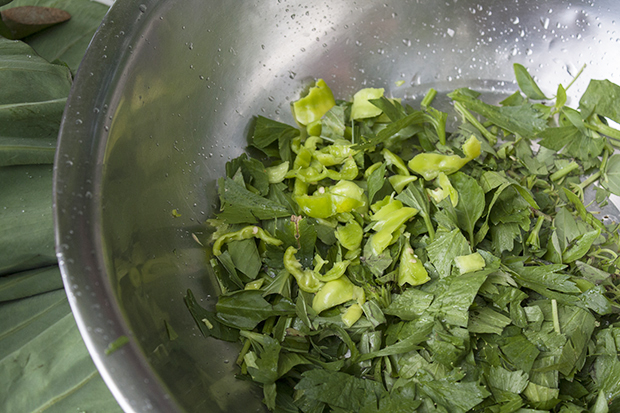

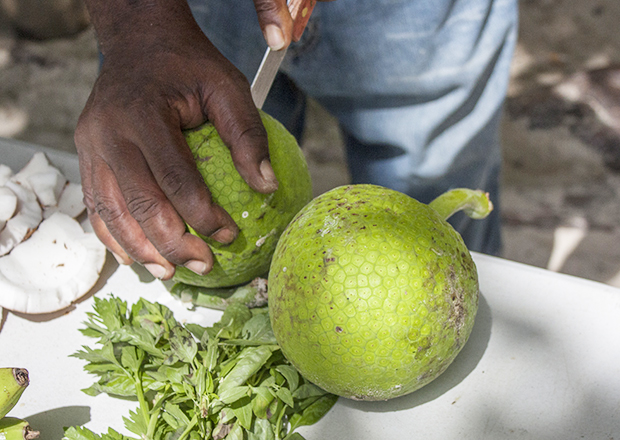
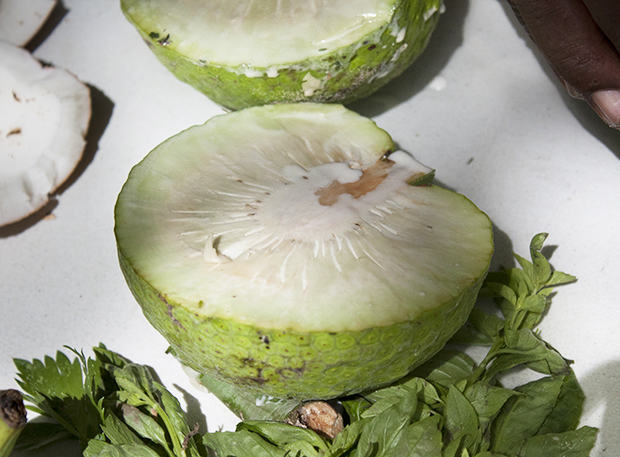
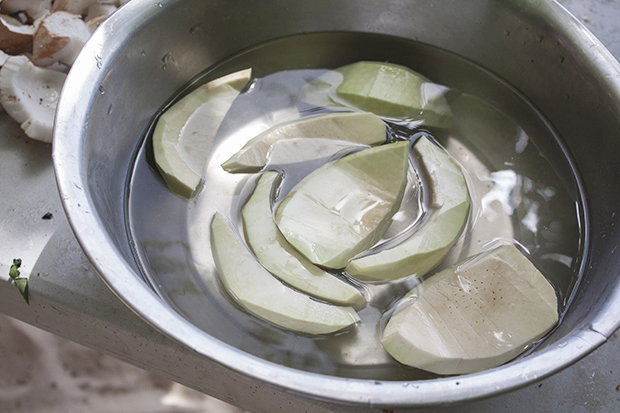
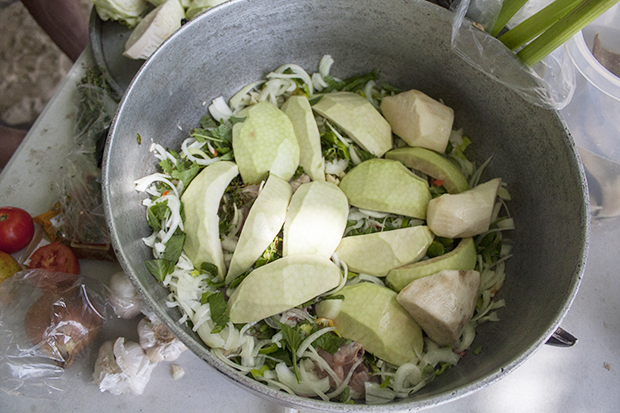
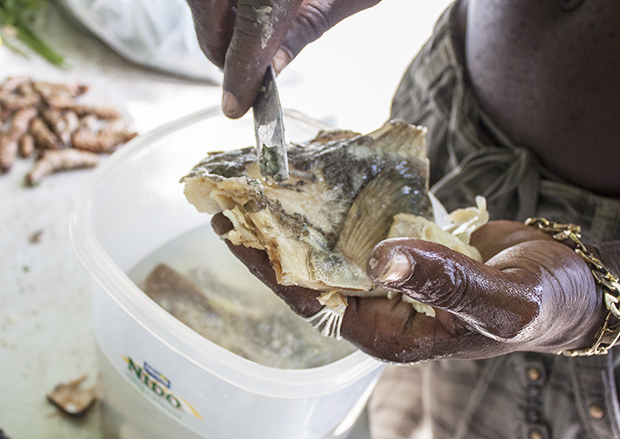
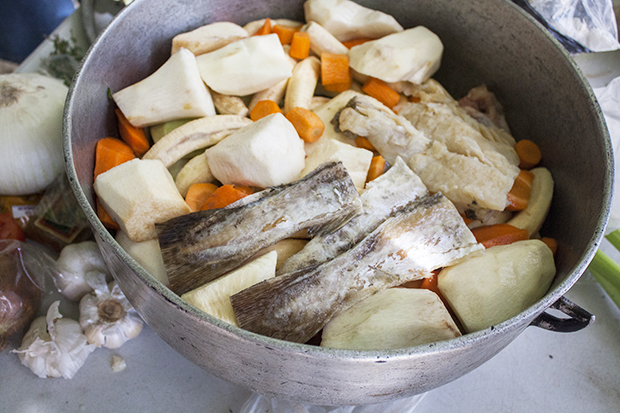
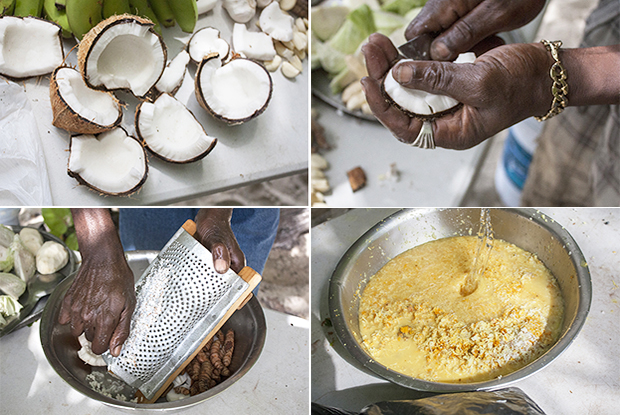
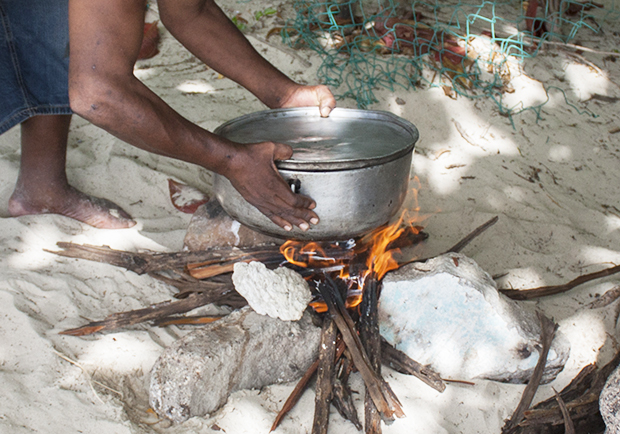

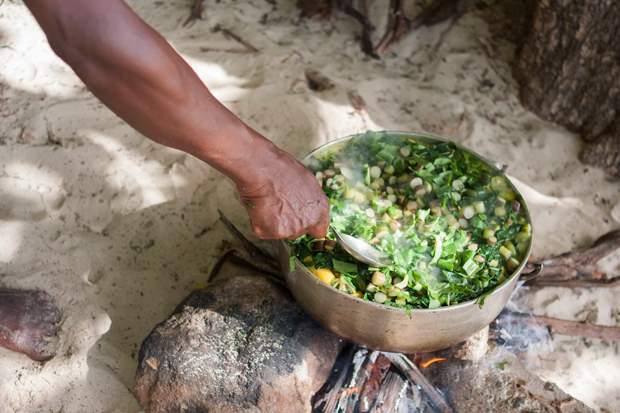
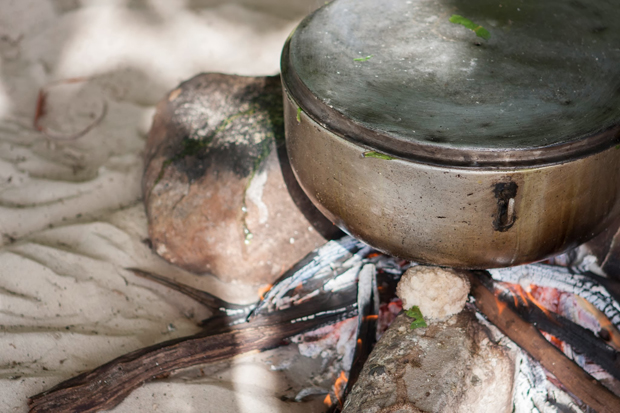
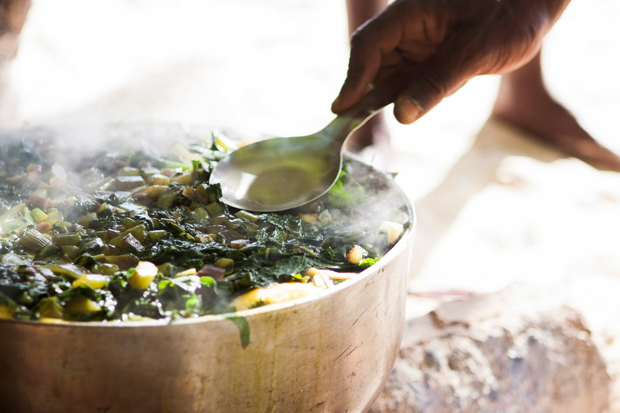
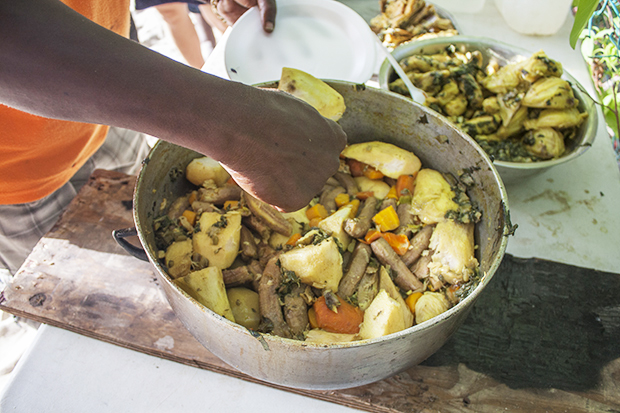












THIS IS A GEM. I saw a reference to ‘Oil down’ 20 minutes ago and was curious because the person referencing it, was making the kinds of faces one only makes when thoroughly satisfied. So I had to look it up and THIS is what I found. These pictures are amazing and the story pairs well with them. I know you said many people don’t know about / visit Greneda but I would visit just sit on the beach and eat this.
You probably get this a lot but … what camera were you using? The images are SO crisp =]